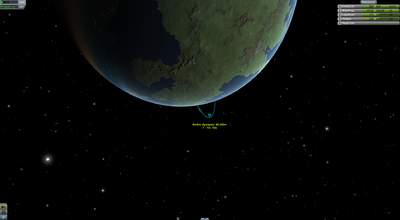Tutorial: Sputnik 1
| “ | SPACE AGE IS HERE - Man-made moon is circling world — Daily Express |
” |
Welcome to the first entry of learning Kerbal Space Program through re-enactment of historical key-missions of the spaceflight history of Earth. This tutorial assumes that you have completed the ingame tutorials so you know the basic controls.
Our first complete mission will be a recreation of the launch of Sputnik, the first man-made object to enter Earths orbit. The successful launch of Sputnik in 1957 by the soviet union was a shock to the whole world. While the space programs by different branches of the US military were mostly impressing with explosions on launchpads unplanned vehicular disassemblies, nobody expected the soviet union to be already so far ahead of them in rocket science. The beeping sound of Sputniks transmitter - strong enough to be picked up by amateur radios all around the world - was a wake up call for the west to finally start taking space exploration seriously. Now we are going to recreate this historical mission.
We will launch a satellite into space and bring it on a stable orbit. Space - for our purpose - starts at an altitude of 45km where the effect of the atmosphere affects objects much less and and thus allows them to enter a stable orbit for several days.
Contents
Ship design
For this mission we will recreate the Soviet R7 rocket. It consisted of a first stage consisting of four engines around a second stage of one and the payload on top.
- Payload stage
- Second stage
- 1x TR-18A Stack Decoupler
- 1x FL-R25 RCS Fuel Tank
- 4x RV-105 RCS Thruster Block (symmetric radial-mounted)
- 1x FL-T800 Fuel Tank
- 1x LV-T30 Liquid Fuel Engine
- First stage
We are going to add a battery bank to the payload, because the Stayputnik command module requires energy to stay operational. During the ascend the engines will generate energy, but after we have it in orbit it will have to work on its own energy reserves. By itself it can store 5 units of energy which keeps it operational for just over 2 minutes. Afterwards it just becomes debris. The Z-500 adds another 500 units of energy which is enough to keep it operational for several orbits. Using the Z-100 battery packs would be more mass-effective, but unfortunately they aren't as elegant to integrate into a rocket design.
Note that the aerodynamic nose cones are technically just for show, because the current version of KSP (0.18.4) doesn't model atmospheric drag correctly. Any part you add to your rocket will make the drag worse, there is no way to reduce drag by adding more parts. Feel free to omit them when you don't care about aesthetics.
Mission phases
Lift-Off
This phase is about getting out of the atmosphere as quickly as possible. The atmosphere creates drag which costs you fuel, so head straight up. Switch on RCS and SAS so you have better control over your rocket, hold shift to set your trottle to maximum, and ignite your first stage by pressing space.
While you ascend, keep the yellow heading indicator on the center of the nav-ball. Every degree of difference and every second costs you valuable altitude later.
When the first stage burnt all its fuel, drop it and ignite the second stage using space (don't press space too often, or you drop your payload). Keep heading straight up.
Going into an orbital flight path
Switch to the orbital view and switch on the nav-ball so you can see your flight path and you apoapsis. Your goal now is to get your apoapsis to about 60km. We need some additional height because we aren't out of the atmosphere yet, so we will keep losing some height due to atmospheric drag. We also need to start building some horizontal velocity so that the gravity affects us less during our ascend to the apoapsis. So start tilting your rocket slightly (about 10° to 20°) to the east (90° on the nav-ball). When you have about half of your fuel left, kill your engines and hope you will reach an apoapsis above 45km.
Getting into a circular orbit
When you reached your apoapsis, perform a prograde boost - orient your rocket horizontal in eastern direction and burn your remaining fuel to get into a circular orbit. Should you run out of fuel, remember that you likely still have plenty of monopropellant left from the ascend. Press H to use it to accelerate forward. It doesn't do much, but it can be enough to give you the crucial last few m/s to get into a stable orbit.
Dropping the payload
After you are in orbit, drop your payload using space. Thanks to the powerful separator it will be blasted forward while the engine stage drifts behind. Congratulation, you just made space history. Go into time-warp and watch your satellite orbit Kerbin gracefully.
What next?
Unfortunately the satellite still has a limited lifetime due to energy use. To extend its life further it needs some kind of energy source in form of photovoltaic panels or a Radioisotope generator. When you have a sustainable energy supply, you can also add some scientific payload like accelerometer, barometer, thermometer or gravimeter. Note that all of this will increase weight and atmospheric drag, so you will need to add some more tanks to your rocket.
When unmanned satellites become boring, it's time to get to the next stage of space exploration: your first manned mission.






